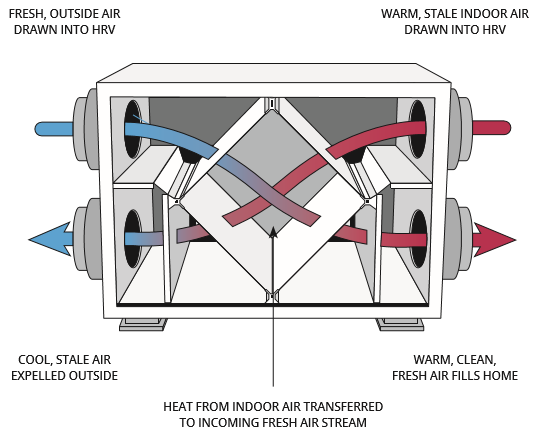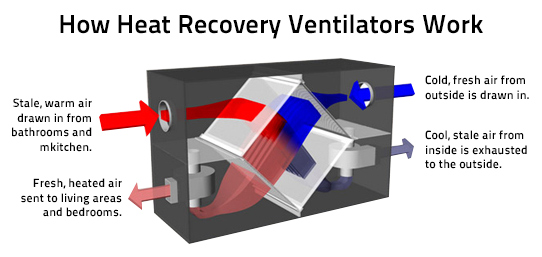How HRV Supports Indoor Air Quality and Healthy Living
Introducing the Secret Conveniences and Uses of Heat Recovery Ventilation in Sustainable Layout
Heat Recovery Ventilation (HRV) systems play a crucial function in sustainable style. They promote a continual exchange of stagnant indoor air with fresh outdoor air, greatly enhancing interior air quality. In addition, HRVs add to power performance by recovering warm from exhausted air, which can decrease energy prices. Comprehending the complex advantages and applications of HRVs exposes their significance in contemporary architecture. What various other advantages do these systems supply in the quest of sustainability?
Recognizing Heat Recovery Ventilation Equipments
Heat recovery ventilation (HRV) systems are developed to enhance indoor air top quality while decreasing energy loss. These systems use a mechanical ventilation method to exchange stale interior air with fresh exterior air, making certain a constant supply of clean air. By catching heat from the exhaust air, HRVs prerequisite incoming air, minimizing the demand on heating and cooling down systems. This process not just boosts thermal comfort but additionally contributes to energy effectiveness in domestic and industrial buildings. Furthermore, HRV systems aid control moisture degrees and decrease interior contaminants, promoting a healthier living environment. Their critical implementation is crucial for attaining sustainable layout goals, as they supply a balance between power conservation and occupant health.
Exactly How HRV Solution Job
While several may be acquainted with ventilation systems, understanding how heat recuperation ventilation (HRV) systems operate is necessary for valuing their advantages. HRV systems operate by exchanging stagnant interior air with fresh outdoor air while transferring heat between the 2 streams. This process takes place in a warmth exchanger, where warm from the outward bound air warms the incoming air throughout chillier months, decreasing energy loss. On the other hand, in warmer months, the system can cool down incoming air making use of the cooler outgoing air. HRVs are outfitted with followers to assist in air flow and filters to remove particulates, making sure a constant, balanced air flow procedure. This cutting-edge style not only improves power performance however also contributes to preserving a comfy interior environment.
Enhancing Indoor Air Top Quality
Indoor air high quality can significantly influence health and well-being, making reliable air flow essential in modern homes. Heat Recovery Ventilation (HRV) systems play a crucial role in keeping interior air top quality by continuously exchanging stagnant interior air with fresh outside air. This process not only reduces air-borne toxins however likewise decreases moisture degrees, which can lead to mold and mildew development and respiratory concerns. HRV systems filter incoming air, removing irritants and particulates, thereby offering a much healthier living setting. Furthermore, these systems aid eliminate odors and unstable organic compounds (VOCs) commonly found in home items. By guaranteeing a constant circulation of tidy air, HRV systems add to a general improved indoor environment, advertising convenience and health for residents.
Power Effectiveness and Price Cost Savings
Power effectiveness attracts attention as a considerable advantage of Heat Recovery Ventilation (HRV) systems. By catching and recycling the heat from tired interior air, HRVs reduce the energy needed for heating incoming fresh air, resulting in decreased power usage. This performance translates into lower utility expenses, supplying substantial cost financial savings for house owners and services alike. In addition, HRV systems often get approved for power performance motivations and rebates, additionally boosting their economic allure. With time, the first financial investment in HRV modern technology can lead to a beneficial return on financial investment via lowered power costs. The integration of HRV systems not just promotes sustainable layout however also provides a sensible option for achieving lasting power financial savings and financial advantages.
Environmental Advantages of HRV

A wide variety of environmental advantages develops from the execution of Heat Recovery Ventilation (HRV) systems. By successfully moving warm from exhaust air to inbound fresh air, HRVs considerably reduce the power required for home heating and cooling spaces. This power efficiency converts to reduce greenhouse gas discharges, adding to a decrease in the general carbon footprint of buildings. In addition, HRV systems improve interior air top quality by continually circulating fresh air, thereby minimizing the focus of interior contaminants and irritants. The decrease in energy consumption help in saving all-natural sources, making HRVs an important part of sustainable layout. On the whole, the ecological advantages of HRVs play a vital function in promoting a healthier world and promoting eco-friendly structure practices.
Versatile Applications in Modern Architecture
Heat recovery ventilation (HRV) systems are progressively being incorporated right into both residential and industrial architectural jobs. In property settings, HRVs boost interior air high quality while maximizing energy efficiency. In business rooms, these systems optimize ventilation strategies, showing their adaptability in modern-day architectural applications.
Residential Projects Integration
While modern-day style progressively emphasizes sustainability, the assimilation of warm recovery ventilation systems in household projects has actually become a useful option for boosting interior air quality and power effectiveness. These systems successfully move warm from exhaust air to incoming fresh air, decreasing power loss top article and minimizing heating or cooling down demands. In new builds and retrofits alike, warm healing ventilation can be flawlessly incorporated, giving homeowners with a much healthier living environment while reducing energy costs. Additionally, with raising awareness of ecological effects, even more architects and contractors are identifying the lasting advantages of these see post systems. Consequently, warmth healing air flow has actually become an important part of sustainable residential design, showcasing flexibility and commitment to environmentally friendly methods.
Business Spaces Optimization
As modern business rooms develop to meet the demands of sustainability and efficiency, the execution of warm recuperation ventilation systems becomes a crucial strategy for enhancing interior settings. These systems help with the exchange of stagnant indoor air with fresh outside air while redeeming warmth power, significantly lowering energy intake. This not just boosts convenience for passengers however additionally helps in reducing functional expenses. Versatile applications can be observed in workplaces, retail spaces, and instructional organizations, where air quality and temperature level control are extremely important. In addition, incorporating heat recuperation air flow straightens with environment-friendly building certifications, even more promoting environmental responsibility. Inevitably, adopting such systems in industrial design not only adds to sustainability goals but additionally fosters much healthier, extra effective spaces for individuals.
Incorporating HRV Into Sustainable Design Practices
Incorporating warmth healing ventilation (HRV) systems right into sustainable style methods offers significant advantages in power effectiveness and Check Out Your URL indoor air quality. By using HRV, designers can produce cost-efficient remedies that not only reduce power consumption yet likewise enhance the general convenience of indoor atmospheres. This positioning with sustainability objectives positions HRV as an important part in modern-day building methods.
Energy Performance Enhancement
By including warm recuperation air flow (HRV) systems right into lasting design techniques, designers and building contractors can substantially boost power effectiveness in modern building and constructions. HRV systems operate by capturing warmth from outgoing stale air and transferring it to inbound fresh air, minimizing the power required for heating or cooling interior rooms. This process not just lowers dependence on typical cooling and heating systems however additionally lowers total power usage. In enhancement, HRV systems can help maintain a consistent indoor temperature, lowering peak energy needs. By integrating these systems, structures can accomplish significant decreases in energy expenses and carbon impacts, aligning with sustainability objectives. Inevitably, HRV technology represents a practical option for boosting energy effectiveness in the developed atmosphere, promoting even more liable resource use.
Indoor Air Quality Renovation
How can warm recovery ventilation (HRV) systems contribute to superior interior air top quality in modern-day buildings? HRV systems successfully exchange stagnant interior air with fresh outside air while recuperating warm energy, minimizing temperature level changes. This procedure minimizes the focus of interior contaminants, such as unpredictable natural compounds (VOCs), irritants, and moisture, which can wear away air high quality and influence passenger health. By keeping optimal moisture levels and making certain a continual supply of clean air, HRVs assist produce a healthier indoor setting. Additionally, these systems can be integrated right into sustainable style techniques, promoting power effectiveness alongside boosted air quality. HRV Heat Recovery Ventilation. HRV technology plays an important function in progressing total resident convenience and wellness in modern building styles.
Affordable Style Solutions

Regularly Asked Questions
What Upkeep Is Needed for Heat Recovery Ventilation Equipments?

Upkeep for warmth recovery air flow systems normally involves routine filter replacements, cleansing of heat exchangers, evaluation of followers and air ducts, and ensuring proper drain. These tasks assist preserve efficiency and prolong the system's lifespan with time.
Can HRV Equipments Be Installed in Existing Buildings?
Heat recovery ventilation systems can certainly be set up in existing buildings. HRV Heat Recovery Ventilation. Retrofitting needs mindful planning and analysis of the structure's format, making sure compatibility with present systems while taking full advantage of energy performance and indoor air top quality
Exactly How Do HRV Systems Impact Sound Levels Indoors?
HRV systems can affect interior noise degrees by introducing sound from outside resources with ventilation. High-grade setups usually integrate sound-dampening functions, minimizing noise impact while offering efficient air exchange and preserving convenience inside your home.
Exist Any Kind Of Downsides to Using HRV Solutions?
The disadvantages of using HRV systems consist of possible high preliminary expenses, maintenance obstacles, and the opportunity of lowered indoor air quality if filters are sporadically altered, which could cause problems with moisture levels.
Exactly how Do I Select the Right HRV System for My Needs?
Picking the best warm recuperation ventilation system involves assessing specific requirements, such as building size, environment, and power performance goals. Furthermore, evaluating system features, installment demands, and maintenance factors to consider is necessary for peak performance and fulfillment.